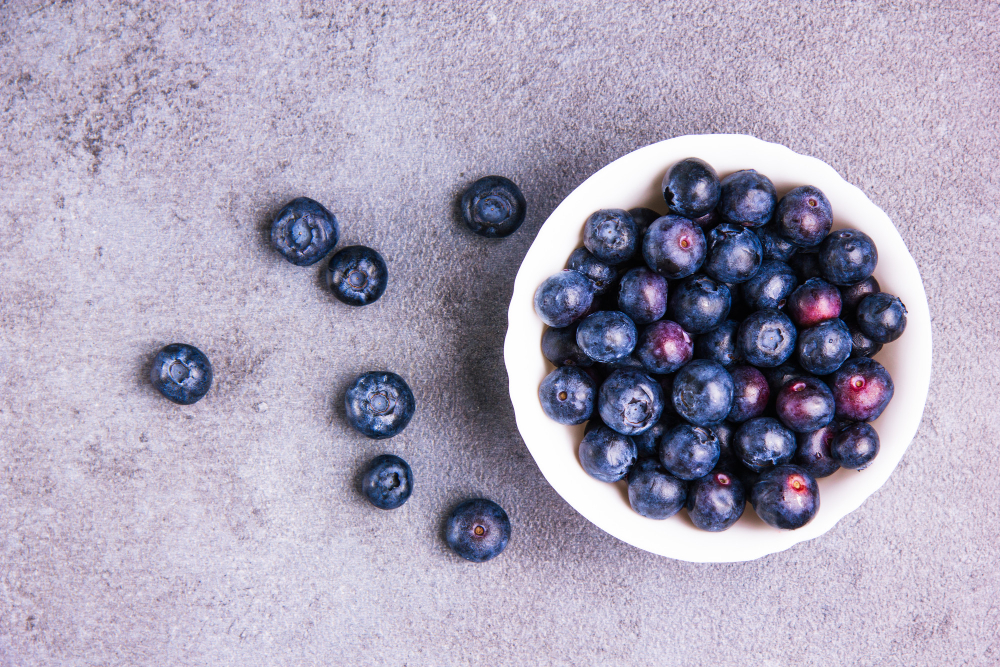
In a world driven by health and wellness trends, “superfoods” have emerged as the superheroes of the culinary universe. These foods, often praised for their exceptional nutrient profiles and potential health benefits, have captured the attention of health-conscious individuals seeking to optimize their well-being. But as we delve into the realm of superfoods, it’s crucial to decipher fact from fiction and explore the nuances that define their place in our diets
Understanding Superfoods
Superfoods are not bestowed with mystical powers but are rather foods that boast an unusually high concentration of vitamins, minerals, antioxidants, or other essential nutrients. This nutritional density is what sets them apart from everyday fare.
Think blueberries packed with antioxidants, kale brimming with vitamins, or salmon teeming with omega-3 fatty acids. These foods have garnered attention for their potential to contribute to various health benefits, including reduced risk of chronic diseases, enhanced cognitive function, and improved energy levels.
What Makes a Superfood?

A. Nutrient Density and Diversity
Superfoods are often characterized by their exceptional nutrient density and diversity. Nutrient density refers to the concentration of essential vitamins, minerals, and other beneficial compounds in a given food relative to its calorie content. In other words, superfoods offer a high amount of nutritional value per calorie, making them efficient choices for meeting your dietary needs
✓Rich in Essential Nutrients: Superfoods typically contain high levels of vitamins such as vitamin C, vitamin K, and vitamin A, as well as minerals like potassium, magnesium, and calcium. These nutrients play crucial roles in various bodily functions, including immune support, bone health, and heart function.
✓ Amino Acids and Protein: Many superfoods are excellent sources of high-quality protein or specific amino acids. For instance, quinoa is renowned for its complete protein profile, containing all nine essential amino acids necessary for human health. Protein-rich superfoods contribute to muscle development, tissue repair, and overall vitality.
✓ Healthy Fats: Some superfoods, like avocados and fatty fish (e.g., salmon), provide healthy fats such as omega-3 fatty acids. These fats are essential for brain health, heart health, and reducing inflammation.
✓ Fiber Content: Superfoods are often fiber-rich, which supports digestive health, helps manage blood sugar levels, and promotes a feeling of fullness, aiding in weight management
B. Antioxidants and Phytochemicals
Antioxidants and phytochemicals are compounds found in many superfoods that contribute to their health-promoting properties. These compounds help protect the body from oxidative stress caused by free radicals, unstable molecules that can damage cells and contribute to various diseases.
✓ Antioxidants: Superfoods are packed with antioxidants like vitamin C, vitamin E, beta-carotene, and various polyphenols. These antioxidants neutralize free radicals, reducing the risk of chronic diseases like heart disease, cancer, and aging-related conditions.
✓Phytochemicals: Phytochemicals are bioactive compounds that give plants their vibrant colors and unique flavors. Examples include the anthocyanins in blueberries and the sulforaphane in broccoli. Phytochemicals have been linked to numerous health benefits, including anti-inflammatory and anti-cancer properties.
C. Scientific Evaluation Criteria

Determining what qualifies as a superfood requires a scientific evaluation process. While the term “superfood” is often used loosely, there are criteria that can guide this assessment
✓ Research and Evidence: Scientific studies should support health claims related to a superfood. Multiple studies demonstrating consistent positive effects on health are essential.
✓ Nutrient Density: A superfood should provide a significant amount of essential nutrients per serving, ideally without excessive calories or unhealthy additives.Safety: Superfoods should be safe for consumption, and potential risks or side effects should be minimal.
✓ Sustainability: Consideration should be given to the environmental impact and sustainability of superfood production. Overharvesting or unsustainable farming practices can have detrimental effects on ecosystems.
✓ Cultural Relevance: Recognize that what is considered a superfood can vary across cultures, and local, traditional superfoods can be just as valuable as exotic imports
Common Superfoods
A. Blueberries

Nutritional Profile
Blueberries are a nutritional powerhouse, rich in vitamins and minerals. They are a good source of vitamin C, vitamin K, and dietary fiber. Blueberries are particularly known for their high levels of antioxidants, including anthocyanins, which give them their vibrant color.
Health Benefits
✓ Antioxidant Protection: Blueberries are celebrated for their ability to combat oxidative stress due to their antioxidants. This may help reduce the risk of chronic diseases like heart disease and cancer.
✓ Cognitive Function: Some studies suggest that regular consumption of blueberries may improve cognitive function and protect against age-related cognitive decline.
✓ Anti-Inflammatory: Blueberries have anti-inflammatory properties, potentially reducing the risk of inflammatory conditions.
Overhyped Claims
While blueberries offer numerous health benefits, it’s essential to avoid overhyped claims. They are not a magic cure for all ailments. It’s crucial to consume them as part of a balanced diet for maximum benefit.
B. Kale

Nutritional Profile
Kale is a leafy green vegetable that is incredibly nutrient-dense. It is a fantastic source of vitamin K, vitamin A, vitamin C, and various minerals, including calcium and potassium. It’s also low in calories.
Health Benefits
✓ Nutrient-Rich: Kale’s nutrient density makes it an excellent choice for promoting overall health and well-being.
✓ Anti-Inflammatory: The antioxidants in kale, such as quercetin and kaempferol, have anti-inflammatory properties that can contribute to a reduced risk of chronic diseases.
✓ Bone Health: Its high vitamin K content is beneficial for bone health.
Misconceptions
Kale became so popular that it was sometimes portrayed as a “miracle” food. While it’s highly nutritious, consuming it excessively can lead to certain health issues, such as thyroid problems due to its goitrogenic properties. A balanced diet is essential
C. Quinoa

Nutritional Profile
Quinoa is a pseudocereal known for its exceptional protein content. It’s a complete protein source, containing all nine essential amino acids. It’s also rich in dietary fiber, vitamins (like B vitamins), and minerals (such as magnesium and iron).
Health Benefits
✓ Protein Source: Quinoa is a valuable plant-based protein source, making it an excellent choice for vegetarians and vegans.
✓ Nutrient-Rich: It provides a wide range of essential nutrients, including magnesium, which is essential for muscle and nerve function.
✓ Gluten-Free: Quinoa is naturally gluten-free, making it suitable for those with gluten sensitivities.
Practicality
Quinoa’s versatility and quick cooking time make it a practical addition to various dishes, from salads to soups. However, its higher cost compared to other grains may limit its accessibility to some individuals.Incorporating these common superfoods into your diet can contribute to better health, but it’s important to do so in moderation and as part of a balanced eating plan. Superfoods are not a replacement for a well-rounded diet but can be valuable components of it.
Emerging Superfoods
A. Spirulina

Nutritional Profile
Spirulina is a blue-green alga and is often considered one of the most nutrient-dense foods on the planet. It is a rich source of complete protein, containing all essential amino acids. It also provides vitamins like B vitamins (especially B12 in some varieties), minerals like iron and magnesium, and essential fatty acids.
Research Findings
✓ Immune Support: Spirulina’s high content of antioxidants, including phycocyanin, may help boost the immune system and reduce inflammation.
✓ Potential Anti-Cancer Effects: Some studies suggest that spirulina’s bioactive compounds may have anti-cancer properties, although more research is needed.
✓ Nutrient Supplementation: Spirulina can be beneficial for individuals with specific nutrient deficiencies, such as B12 for vegetarians and vegans.
Potential Risks
✓ Contamination: Quality control is critical when consuming spirulina, as it can be contaminated with toxins if not sourced and processed properly.
✓ Allergic Reactions: Some individuals may be sensitive or allergic to spirulina, resulting in adverse reactions.
✓ Interactions: Spirulina may interact with certain medications or medical conditions, so it’s essential to consult a healthcare professional before adding it to your diet
B. Chia Seeds

Nutritional Profile
Chia seeds are tiny black or white seeds that pack a nutritional punch. They are rich in dietary fiber, providing both soluble and insoluble fiber. Chia seeds are also a good source of plant-based protein, healthy fats (omega-3 fatty acids), vitamins (like B vitamins), and minerals (such as calcium and magnesium).
Health Benefits
✓ Digestive Health: The soluble fiber in chia seeds can aid digestion, regulate blood sugar levels, and promote a feeling of fullness.
✓ Omega-3 Fatty Acids: Chia seeds are an excellent source of alpha-linolenic acid (ALA), a type of omega-3 fatty acid that supports heart health.
✓ Versatile Usage: Chia seeds can be easily incorporated into a variety of dishes, including smoothies, yogurt, oatmeal, and baked goods
Realistic Usage
While chia seeds offer numerous health benefits, it’s important to consume them in moderation. Excessive consumption can lead to digestive discomfort due to their high fiber content.
C. Acai Berries

Nutritional Profile
Acai berries are small, dark purple fruits native to the Amazon rainforest. They are known for their high antioxidant content, particularly anthocyanins. Acai berries also provide fiber, healthy fats, and small amounts of vitamins and minerals.
Hype vs. Reality
Acai berries gained popularity as a “superfood” due to their antioxidant content. However, many products featuring acai, such as juices and supplements, may contain added sugars and may not deliver the same health benefits as whole berries.Scientific evidence supporting specific health claims attributed to acai is limited, and more research is needed to confirm its potential benefits.
Sustainability Concerns
Acai berry harvesting can have environmental implications, as demand has led to overharvesting in some regions. Sustainable and responsible sourcing practices are essential to address these concerns and protect the ecosystem.
✓ Incorporating emerging superfoods like spirulina, chia seeds, and acai berries into your diet can offer various health benefits. However, it’s crucial to be informed about their nutritional profiles, realistic usage, and potential risks to make informed dietary choices. Additionally, sourcing these foods responsibly can help support sustainable and ethical practices.
Superfood Myths and Misconceptions ( Myth vs. Reality)

A. One-Size-Fits-All Approach
Myth:
One common misconception about superfoods is that they offer a universal solution to everyone’s health needs. Some people believe that by incorporating a handful of trendy superfoods into their diet, they can achieve optimal health regardless of individual factors.
Reality:
There is no one-size-fits-all approach to nutrition. People have unique dietary requirements based on factors such as age, gender, genetics, activity level, and underlying health conditions. What works for one person may not work for another. While superfoods can be highly nutritious, they should be part of a balanced diet tailored to individual needs.
B. Miracle Cure Claims
Myth:
Superfoods are often portrayed as miracle cures for various health conditions. Some marketers and wellness influencers exaggerate their benefits, suggesting that consuming a specific superfood can cure diseases or drastically improve health overnight.
Reality:
While superfoods can contribute to a healthy diet and may offer preventive health benefits, they are not magical panaceas. Health conditions are often complex and multifactorial, requiring a holistic approach that includes a balanced diet, exercise, proper medical care, and other lifestyle factors. Relying solely on superfoods to cure or prevent illnesses is unrealistic and can lead to disappointment.
C. Neglected Local Superfoods
Myth:
Many people focus on exotic superfoods from distant countries while neglecting the nutritional treasures available locally. Local superfoods often go unnoticed or undervalued in favor of trendy imports.
Reality:
Every region has its own array of nutrient-rich foods that are well-suited to the local climate and culture. These local superfoods can be just as nutritious and beneficial as exotic imports. Neglecting them not only misses out on their health advantages but also overlooks the importance of sustainable and locally sourced ingredients. Embracing local superfoods supports regional agriculture and reduces the carbon footprint associated with importing distant foods.
Superfoods in a Balanced Diet

A. Dietary Diversity
Dietary Diversity Importance:
Including superfoods in a balanced diet is a smart choice, but it should be part of a broader approach to dietary diversity. Eating a variety of foods from different food groups ensures that you obtain a wide range of essential nutrients necessary for overall health.
Balancing Superfoods with Other Foods:
While superfoods are nutrient-dense and offer unique health benefits, they should not dominate your diet at the expense of other important food groups. Strive for diversity by incorporating fruits, vegetables, whole grains, lean proteins, and healthy fats alongside superfoods.
Preventing Nutrient Gaps:
A diverse diet reduces the risk of nutrient deficiencies. Different foods provide various vitamins, minerals, and phytochemicals, contributing to a well-rounded nutritional profile. Superfoods can supplement this diversity by adding specific nutrients to your diet.
B. Portion Control
Balancing Superfood Portions:
Portion control is essential when incorporating superfoods into your diet. Even nutrient-dense foods can contribute excess calories if consumed in large quantities. Pay attention to serving sizes to maintain a balanced calorie intake.
Avoiding Overconsumption:
Overeating superfoods can lead to imbalances in your diet and may result in digestive discomfort or weight gain. For instance, chia seeds, despite their health benefits, are very high in fiber, and excessive consumption can lead to gastrointestinal issues.
Remembering Balance:
Superfoods should complement your overall diet rather than becoming the main focus. Be mindful of portion sizes and calorie intake, especially if you’re using superfoods in smoothies, snacks, or recipes.
C. Incorporating Superfoods Sensibly
Variety of Superfoods:
Just as you should aim for dietary diversity, you can also diversify your selection of superfoods. Different superfoods offer distinct nutrients and health benefits. Rotate your choices to ensure you benefit from a wide spectrum of these foods.
Cooking and Preparation Methods:
How you prepare superfoods matters. For example, steaming vegetables like broccoli helps retain their nutrients better than boiling. Avoid excessive frying or adding sugary or high-calorie toppings when incorporating superfoods into your meals.
Balance Convenience and Whole Foods:
While fresh, whole superfoods are ideal, frozen, dried, or canned versions can be more convenient and still nutritious. Be cautious about added sugars, sodium, or preservatives in processed superfood products and opt for minimally processed options when possible.
Consulting a Nutritionist:
If you have specific dietary goals or health concerns, consider consulting a registered dietitian or nutritionist. They can help you create a personalized meal plan that incorporates superfoods sensibly while addressing your unique needs.
Final Thoughts and Advice
navigating the realm of superfoods, remember that they’re valuable contributors to a healthy diet, but not magical solutions. Embrace dietary diversity, practice portion control, and opt for whole, minimally processed options.
Rotate superfood choices for a variety of nutrients, and don’t overlook local treasures. Consult professionals for personalized advice, and remain realistic about their impact. Sustainability matters – choose superfoods responsibly. Ultimately, a well-rounded lifestyle, coupled with sensible superfood incorporation, paves the way for lasting health and vitality.
